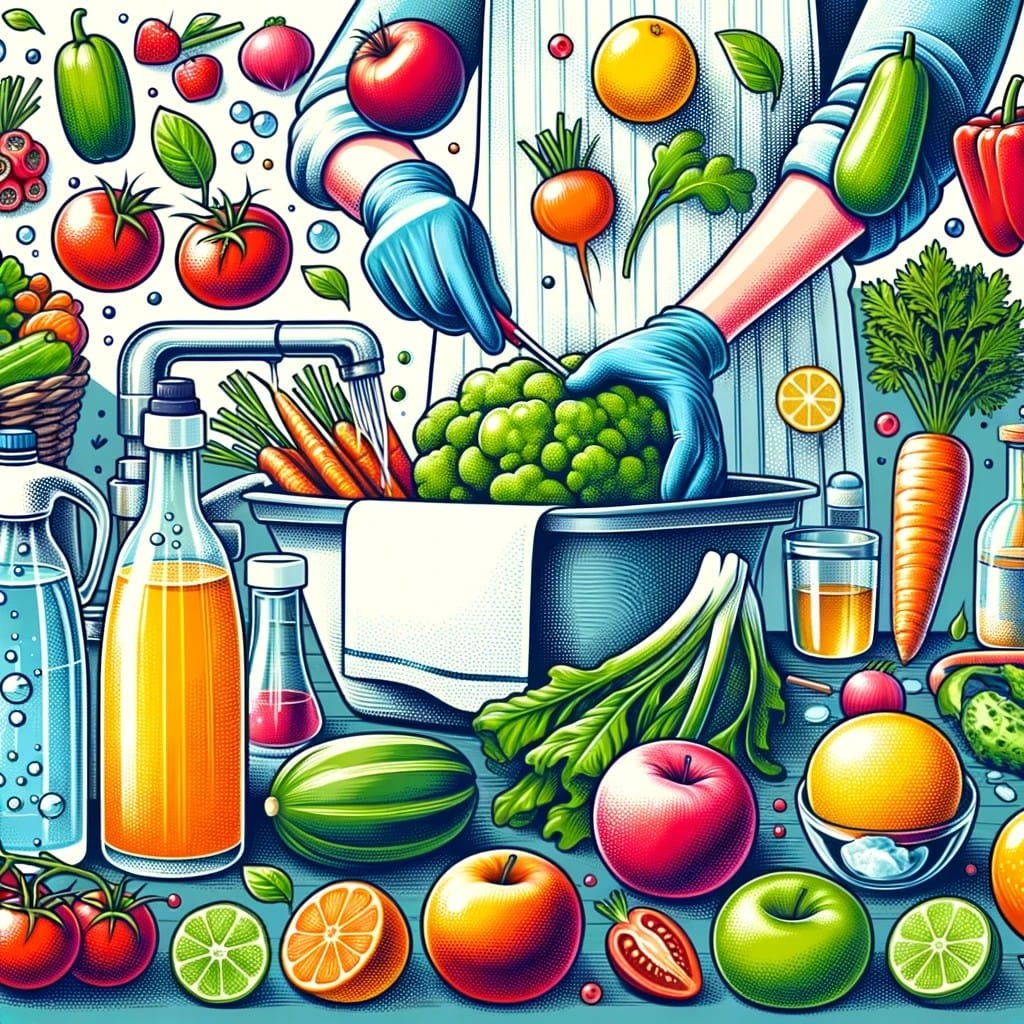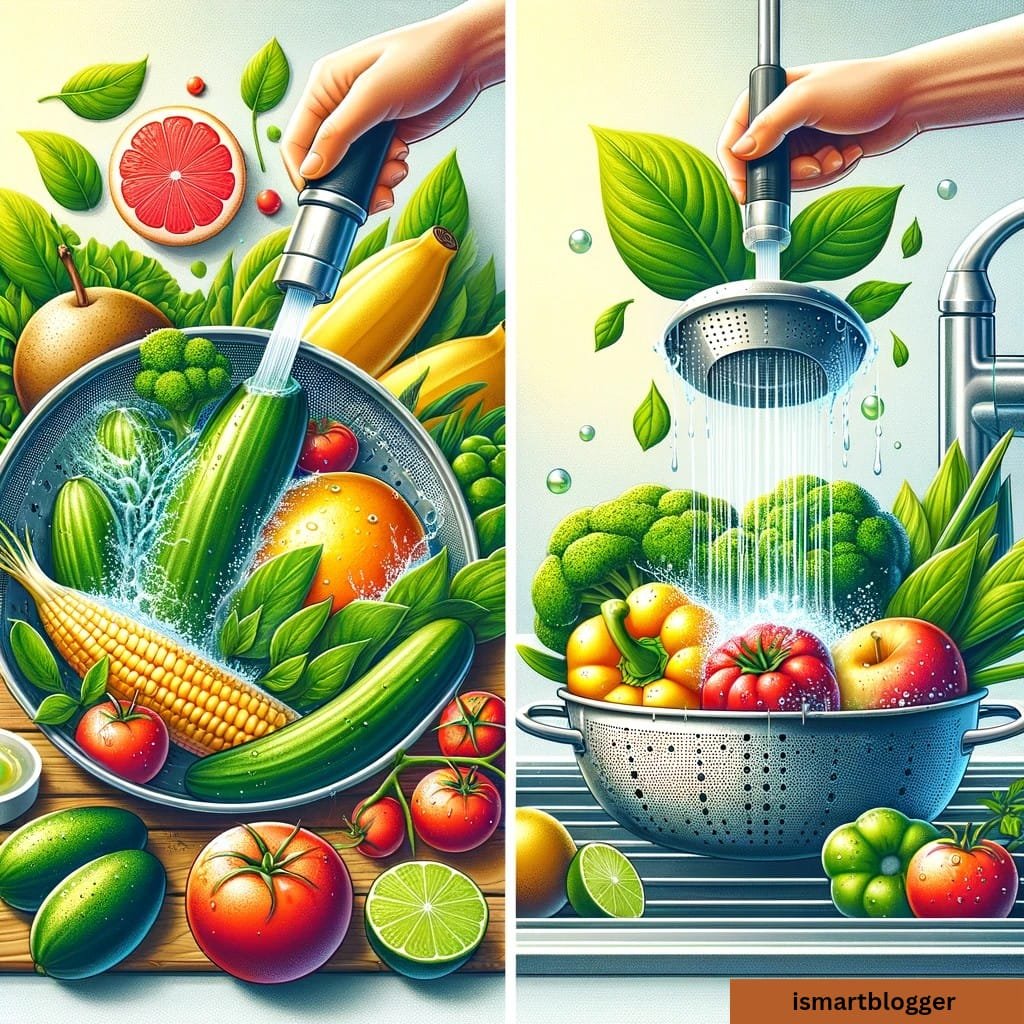Introduction
In today’s increasingly industrialized world, the importance of cleaning and removing pesticides from fruits and vegetables cannot be overstated. These essential staples of a healthy diet are not always as innocent as they appear.
Pesticides, while serving their intended purpose of protecting crops from pests and diseases, can leave behind harmful residues that pose risks to human health. Therefore, it is crucial to understand the potential dangers associated with pesticide residues and take appropriate measures to ensure our produce is safe for consumption.
The Importance of Cleaning and Removing Pesticides from Fruits and Vegetables
Fruits and vegetables are an integral part of a balanced diet due to their abundance of essential vitamins, minerals, fiber, and antioxidants. However, when these nutritious foods become carriers of pesticide residues, their health benefits may be overshadowed by potential risks.
Studies have linked long-term exposure to pesticides with an increased risk of various health issues such as cancer, neurodegenerative diseases, hormonal imbalances, developmental problems in children, and compromised immune systems. Moreover, pesticide residues can persist on the surface of produce even after washing or peeling.
This is particularly concerning since many people consume fruits and vegetables raw or lightly cooked and these residues are not eliminated by heat during the cooking process. Therefore, taking proactive steps to clean and remove pesticides becomes vital for safeguarding our well-being.

Overview of the Potential Health Risks Associated with Pesticide Residues
Pesticides used in conventional farming practices can linger on fruits and vegetables in various forms such as sprays or systemic treatments absorbed by plants’ tissues. These chemical compounds may disrupt the delicate balance within our bodies’ systems when ingested regularly over time. Certain pesticides have been classified as carcinogens by regulatory agencies, meaning they have the potential to cause cancer in humans.
The buildup of these substances in our bodies can lead to cellular damage and mutations, which may ultimately develop into cancerous growths. Furthermore, pesticides can interfere with our neurological system, affecting cognitive functions, memory, and behavior.
Some pesticides act as endocrine disruptors, mimicking or interfering with hormones in the human body. This disruption can lead to reproductive issues, developmental abnormalities in fetuses and children, and even impact overall hormonal balance.
Purpose of the Outline: Providing a Comprehensive Guide on Effective Pesticide Removal
The purpose of this outline is to serve as a comprehensive guide for individuals seeking effective methods to clean and remove pesticides from their fruits and vegetables. By understanding the risks associated with pesticide residues and implementing proper cleaning techniques, we can minimize our exposure to these harmful substances while still enjoying the nutritional benefits of fresh produce.
Throughout this article, we will explore various washing techniques and soaking methods specifically designed for different types of fruits and vegetables. By following these guidelines carefully, you can ensure that your produce is free from harmful pesticide residues.
Understanding PesticidesDefinition and types of pesticides commonly used in agriculture:
Pesticides are chemical substances utilized in agricultural practices to protect crops from pests, diseases, and weeds. They play a crucial role in maintaining agricultural productivity and food security.
The types of pesticides commonly employed include insecticides, herbicides, fungicides, rodenticides, and bactericides. Insecticides target insects that damage crops by feeding on leaves, stems, or fruits.
Herbicides are designed to control unwanted plant growth or eliminate weeds competing with cultivated plants for nutrients and water. Fungicides aim to combat fungal diseases that can devastate crops by impairing their growth or causing rotting.
Rodenticides help manage rodent populations that may damage crops or spread diseases. Bactericides specifically target bacteria posing threats to plants’ health.
How pesticides are applied to fruits and vegetables:
Pesticide application on fruits and vegetables typically involves spraying or using systemic methods through soil treatment or seed coating. Spraying is the most common method used in which liquid pesticide formulations are sprayed directly onto the plants using specialized equipment such as handheld sprayers or tractor-mounted sprayers.
This technique ensures comprehensive coverage of the plant’s surfaces with the pesticide solution. Systemic methods involve applying pesticides to the soil where they are absorbed by the roots and transported throughout the plant’s tissues via its vascular system, providing internal protection against pests.
Potential health effects of pesticide residues on human health:
While pesticides contribute significantly to crop protection, their presence as residues on fruits and vegetables raises concerns about potential health effects when consumed by humans. Pesticide residues can find their way onto produce through direct application during cultivation or from environmental contamination such as air drift from nearby fields where pesticides were used.
Prolonged exposure to these residues, even at low levels, has been linked to a range of health issues. Some pesticides are known to be neurotoxic and may pose risks to the nervous system.
Others have been associated with hormonal disruptions, reproductive disorders, and even certain types of cancer. Moreover, children and pregnant women are particularly vulnerable as their developing bodies may be more susceptible to the effects of pesticide exposure.
Understanding the different types of pesticides used in agriculture, how they are applied to fruits and vegetables, and the potential health effects associated with pesticide residues is crucial for consumers who aim to reduce their exposure. By being informed about these matters, individuals can better understand why thorough cleaning methods are necessary to remove or minimize pesticide residues on produce before consumption.
III. Identifying High-Risk Produce
Overview of the “Dirty Dozen” list – twelve fruits and vegetables with high pesticide residue levels
When it comes to identifying high-risk produce, the “Dirty Dozen” list serves as a valuable resource. This list, compiled annually by the Environmental Working Group (EWG), highlights the twelve fruits and vegetables that tend to have the highest levels of pesticide residues.
By being aware of these specific items, consumers can prioritize their cleaning efforts and make informed choices about organic alternatives. The current “Dirty Dozen” list includes popular produce items such as strawberries, spinach, kale, nectarines, apples, grapes, peaches, cherries, pears, tomatoes, celery, and potatoes.
These fruits and vegetables have consistently demonstrated higher pesticide residue levels compared to others. Therefore, it is crucial to pay extra attention when cleaning them thoroughly before consumption.
Other factors to consider when determining produce at risk: are origin, farming practices, and seasonality
While the “Dirty Dozen” list provides valuable guidance in identifying high-risk produce items in terms of pesticide residues alone, there are other factors that should also be taken into account. One such factor is the origin of the produce.
Different countries may have varying regulations and practices regarding pesticide usage. It is advisable to research or choose locally grown options whenever possible as they generally adhere to stricter regulations.
Furthermore, understanding farming practices can help in assessing produce risk. Some farms adopt conventional methods that involve more intensive pesticide use compared to organic or sustainable farms that prioritize natural pest control methods.
Familiarizing yourself with different farming practices will allow you to make more informed decisions about which products are likely to have higher pesticide residues. Seasonality also plays a role in determining produce risks since certain fruits and vegetables are more prone to pests during specific times of the year.
For example, strawberries and leafy greens are often at higher risk during the summer months when pests are more prevalent. It is important to consider these seasonal variations and intensify cleaning efforts accordingly.
By being aware of the “Dirty Dozen” list and considering additional factors such as origin, farming practices, and seasonality, consumers can make informed decisions about which produce items may require more attention in terms of cleaning and pesticide removal. Taking these factors into account helps prioritize efforts to minimize pesticide exposure from fruits and vegetables consumed regularly.
Washing Techniques for Fruits and Vegetables
Preliminary steps before washing
Before diving into the actual washing process, it is crucial to undertake a few preliminary steps to ensure effective cleaning of your fruits and vegetables. Start by carefully inspecting the produce and removing any outer leaves that appear wilted, damaged, or dirty. These outer layers are more likely to harbor pesticide residues or microbial contaminants.
Additionally, peeling certain fruits and vegetables like apples or potatoes can further reduce potential pesticide exposure as most residues tend to accumulate on the skin. However, remember that some nutrients reside just beneath these skins, and peeling may lead to nutrient loss.
Explanation of why certain steps are necessary for effective cleaning
The preliminary steps mentioned above are essential because they help eliminate the majority of surface-level contaminants from your produce. Pesticide residues can adhere strongly to the skin or outer leaves, making them resistant to simple washing techniques alone. By removing these parts, you minimize potential exposure to harmful substances while ensuring a cleaner eating experience.
Examples of produce that require specific preparation
Certain types of produce require specific preparation methods due to their unique characteristics and susceptibility to contamination. Berries, such as strawberries or blueberries, have delicate skins that can easily absorb pesticides used during cultivation.
It is essential to gently rinse them under running water without rubbing too vigorously as this may damage their fragile structure. Leafy greens like spinach and lettuce should be soaked in cool water for several minutes before rinsing thoroughly under running water since dirt and chemicals may cling between their crevices.
For firmer fruits and vegetables like apples or cucumbers, you can use a vegetable brush along with a mild detergent solution (if preferred) while scrubbing under running water. The brush helps remove any wax coatings applied for preservation purposes in addition to eliminating surface-level contaminants effectively.
Proper washing techniques for different types of produce
To ensure the thorough cleaning of various types of produce, it is crucial to adapt washing techniques based on their characteristics. Delicate fruits and leafy greens should be gently swirled in a bowl of cool water or placed under running water, allowing the gentle flow to dislodge any contaminants.
On the other hand, firmer produce can be scrubbed with a vegetable brush while holding them under running water. When using water alone, let it flow in a steady stream to carry away any residues or dirt effectively.
Alternatively, if you choose to use mild detergent solutions, ensure they are specifically formulated for fruit and vegetable cleaning. After applying the solution, rinse the produce thoroughly several times under running water to remove any traces of detergent.
Step-by-step instructions for handwashing using water only or mild detergent solutions
1. Remove outer leaves: Inspect your fruits and vegetables and remove damaged or wilted outer leaves. 2. Peel if necessary: Consider peeling certain fruits and vegetables such as apples or potatoes. 3. Rinse with cool water: Place delicate produce like berries or leafy greens in a colander and rinse them gently under cool running water.
4. Gently swirl: For delicate produce, gently swirl them in a bowl of cool water. 5. Scrub firmer fruits and vegetables: For firmer produce like apples or cucumbers, use a vegetable brush while rinsing them under running water.
6a. Handwashing (water-only): Submerge the produce under running tap water while rubbing it gently with your hands for additional cleaning.
6b. Handwashing (mild detergent): Apply a small amount of mild fruit and vegetable wash to your hands before rubbing each item individually for approximately 20 seconds per piece. 7. Rinse thoroughly: After completing the washing step above (water-only or mild detergent), rinse each item under running water to remove any remaining residues or traces of detergent.
Tips for using commercial fruit and vegetable washes effectively
When opting for commercial fruit and vegetable washes, follow the manufacturer’s instructions carefully. These products are specifically designed to remove residues effectively.
Ensure that the wash you choose is labeled as safe for consumption on food items. Thoroughly rinse your produce after using a commercial wash to eliminate any remaining residue from the cleaning solution.
Additionally, storing washed fruits and vegetables in clean containers or bags can help maintain their cleanliness until consumption. Remember that proper washing techniques, regardless of the method used, are crucial to minimize pesticide exposure and ensure the safe consumption of your produce.
Soaking Methods for Pesticide Removal
Explanation of why soaking can be an effective method
Soaking is a highly effective method for removing pesticide residues from fruits and vegetables. Pesticides are often oil-based or water-resistant, making them difficult to eliminate through simple washing alone.
Soaking allows for a more thorough penetration of water into the produce, aiding in the removal of pesticide residues that may have adhered to the skin or seeped into the flesh. It is particularly beneficial when dealing with produce with uneven surfaces, such as strawberries or broccoli florets, where contaminants can hide in crevices.
Different soaking methods based on the type of produce
The choice of soaking method depends on the type of produce being cleaned. Two common methods involve using a vinegar-water solution or a saltwater solution.
Soaking in vinegar-water solution
Creating a vinegar-water solution is an effective way to remove pesticide residues from most fruits and vegetables. For optimal results, mix one part white vinegar with three parts water.
Place the produce in a bowl or sink and completely submerge it in the solution. Let it soak for approximately 15-20 minutes while gently agitating occasionally to ensure proper coverage.
Afterward, rinse thoroughly under cold running water to remove any remaining vinegar taste. Proper ratios and duration for soaking may vary slightly depending on personal preference and sensitivity to taste.
However, it’s essential not to exceed recommended concentrations as excessive amounts of vinegar may alter flavors or cause texture changes in certain produce. Vinegar helps remove pesticide residues through its acidic properties that break down pesticides’ waxy coatings and facilitate their removal during rinsing.
Soaking in saltwater solution
Some studies suggest that soaking produce in salt water can also help reduce pesticide residues effectively. To prepare a saltwater solution, dissolve two tablespoons of salt in four cups of water. Soak the produce in the solution for about 15 minutes, making sure it is completely submerged.
After soaking, rinse thoroughly with cold water to remove any excess salt. While the mechanism behind saltwater’s effectiveness is not yet fully understood, it is believed that the osmotic properties of saltwater aid in drawing out pesticide residues from the surface of fruits and vegetables.
Conclusion
In our quest for a healthier diet, it is crucial to prioritize cleaning and removing pesticide residues from our fruits and vegetables. Soaking methods utilizing vinegar-water or saltwater solutions provide effective ways to enhance produce cleanliness and minimize potential health risks associated with pesticides.
By following proper ratios and durations for soaking, we can ensure the thorough removal of pesticide residues without compromising flavor or texture. While vinegar aids in breaking down pesticides’ waxy coatings during rinsing, saltwater’s osmotic properties contribute to removing contaminants from produce surfaces. Using these soaking methods as part of a comprehensive cleaning routine allows us to enjoy peace of mind when consuming fresh fruits and vegetables. Embracing these techniques empowers us to make healthier choices for ourselves and our loved ones while supporting sustainable farming practices that prioritize environmental stewardship.





